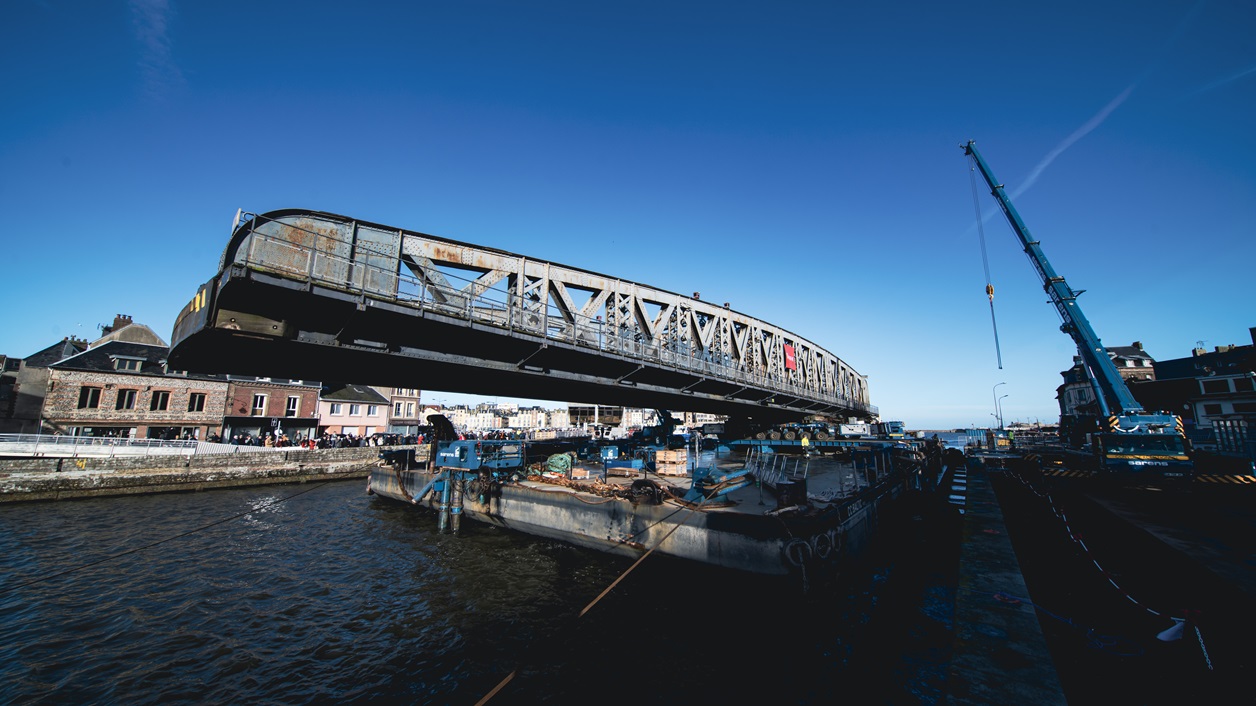
Imagine loading out a one-of-a-kind, historic 840-tonne bridge in the midst of rapidly-changing tides and water levels, all surrounded by the commotion of a busy city and on a quayside barely built to support its weight.
At Sarens, we don’t just imagine it: we design innovative solutions that make it possible. When our client, Eiffage Métal, set out to remove and renovate the Pont Colbert bridge in Dieppe, France, it was the start of a sophisticated operation involving complex calculations, jacking towers, SPMTs, supports, load spreading mats, a barge, bridges, winches and ballast pumps.
But this story stretches back in time, far before the first calculations were made and plans for renovation drawn up. Because the Pont Colbert is not just any bridge: it is the last remaining hydraulic turning bridge in Europe, and a beloved symbol of the local heritage.
From the time it was assembled in 1888, it required skilled bridgemen, passing their knowledge down through generations, to operate. It has withstood bombing at the close of World War II, grown to support a daily traffic flow of 12,000 vehicles, and inspired spirited local campaigners determined to preserve it for future generations.
That is how, this year, Sarens found ourselves stepping into the swirl of history and heritage surrounding this unique bridge. Our client, however, has been a part of its story from the beginning. Eiffage Métal was originally the Company of Bridges and Iron Works–the same company that bid against the famous Gustave Eiffel to build the bridge’s main structure, and won. Now, more than a century later, it was time to rebuild it anew.
Sarens was entrusted with helping Eiffage Métal load out the bridge so it could be renovated and reinstalled again in all its glory. However, we knew that the operation would be complex, demanding, and require true engineering grit.
Because the tides and water levels changed daily, all the calculations and meticulous preparations for load out were done for one specific day. If we were to miss that window, the operation would have been postponed by weeks. And since the water level rose eight metres in the span of less than six hours, the timing of the load out operation left absolutely no room for error.
The project’s location added a further layer of complexity: because the work site was in the middle of the city, the equipment was positioned in the street for offloading as traffic continued to flow around it.
But the team faced yet another hurdle: the quayside was not strong enough to support the weight of both SPMTs and the bridge. To counteract this challenge, a long, heavy beam was installed over two strong points on the quay so that the load could safely be driven over it.
Sarens took care to address all of the project’s special requirements, including the specific support points for the SPMTs and jacking towers, during the planning phases.
Ultimately, the following equipment was chosen for the operation:
Almost all the equipment arrived from Wolvertem via 40 truckloads, where it was then installed in phases. The jacking equipment, however, presented the biggest rigging challenge because it had to be installed under the bridge and in a difficult-to-access pit.
With everything meticulously prepared and in place, it was time for the offload and transport operation. The crew moved the 840-tonne, 70-metre long Point Colbert bridge safely and securely despite quickly-changing water conditions, which the team adapted to by ballasting the barge.
The bridge was jacked up and loaded out, then driven from the quay straight onto the barge, transferred to the port, driven from the barge onto the other quay, rotated 180°, and finally set down at the restoration site.
All together, 16 people worked in two shifts during the load out operation. The equipment remained onsite for two weeks, with a week each dedicated to mobilisation and demobilisation.
Sarens is proud to have played our role in the story of this beautiful historic bridge, and would like to warmly congratulate everyone involved in this successful and complex operation!